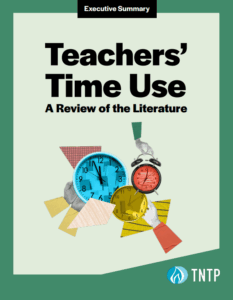It’s been almost two years since COVID forced public education to grind to a halt. While most students are now back in classrooms, schools are still enduring unprecedented challenges. One challenge in particular has defined the current school year: teacher shortages.
Many schools across the country are facing their toughest staffing situation in recent memory, with a large number of teachers thinking of quitting, taking leaves of absence, or actually resigning; a depleted pool of substitute teachers; and fewer people applying to fill vacancies in a job market that’s pushing people away from relatively low-paid careers like teaching. It’s all happening at a moment when students need diverse, effective teachers more than ever to help them accelerate back to grade level after the disruption of the past two years.
Today, we’re releasing a new resource to help district leaders navigate these challenges, called Addressing Teacher Shortages: Practical Ideas for the Pandemic and Beyond
This guide is designed to help district leaders understand and respond to the specific staffing gaps they’re facing, based on best practices we’ve gathered working with hundreds of school systems over almost 25 years. It offers time-tested strategies that will make an immediate impact: ideas for covering absences, filling existing vacancies, and addressing chronic shortages exacerbated by the pandemic in key subject areas and in schools serving historically marginalized communities. We’ve also included guiding questions to help districts quickly identify their most urgent talent priorities and find the sections of the guide most relevant to them.
But as districts respond to their immediate staff shortages, it’s important to acknowledge that those challenges are symptoms of a larger problem. The current crisis has reinforced fundamental questions about our approach to staffing classrooms and the value proposition of teaching as a career. We’ve known for decades that the combination of low pay, lackluster career growth opportunities, and a job description that borders on impossible (meeting the wide-ranging needs of an entire class by yourself) pushes talented people away from teaching—a trend that is only accelerating amid the “Great Reshuffle.” Especially with the availability of Recovery Act funds, districts have an important opportunity to plan and build momentum for longer-term changes to teacher pipelines, the employee value proposition for teachers, and the teacher role itself that will bring many more talented professionals into the classroom. We’ve included advice throughout the guide on how to jumpstart that planning process with stakeholders inside and outside education—because this isn’t work districts can or should have to do alone.
In the coming months, we’ll be sharing more resources and research on how school systems can address teacher staffing challenges as part of a broader learning acceleration strategy—so that all students, especially historically marginalized students, have the support and high-quality school experiences they need in the critical years ahead.
Feel free to share this guide with anyone in your networks who might find it useful. If you’d like to learn more about any of the strategies in the guide or find out how TNTP can help you implement them in your school system, please let us know using this form.








